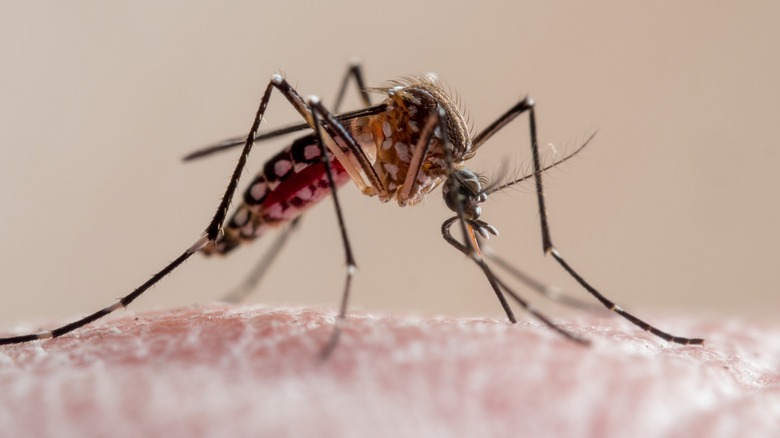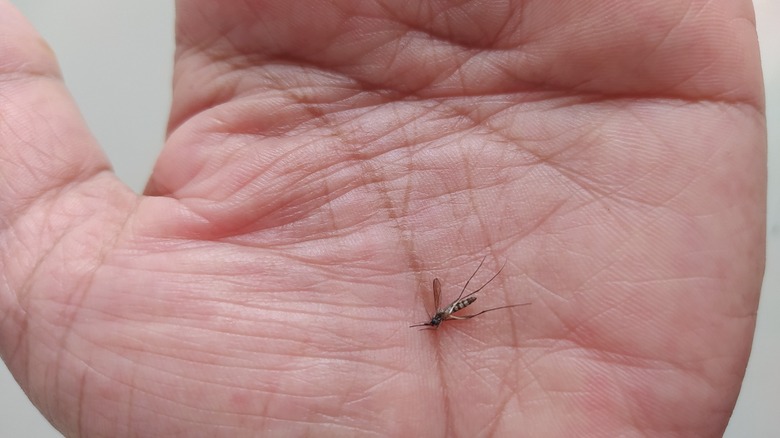An Invasive Mosquito Breed Was Just Found In Idaho. Here's What It Could Mean
Idaho public health officials have confirmed the state's first detection of Aedes aegypti, a mosquito species capable of spreading viruses such as Zika, yellow fever, and dengue fever. The insect was identified in Canyon County, where mosquito abatement teams are now monitoring to see if this is an isolated case. While there is no reason to panic, the news is understandably unsettling.
Mosquitoes are the deadliest animals on Earth. They're responsible for spreading diseases that in turn cause more than 700,000 human deaths every year, according to the World Health Organization. Still, not all mosquitoes are dangerous. For many species, the biggest consequence of a bite is the itchy welt it leaves behind. The problem is that others, like Aedes aegypti, are notorious vectors for much more serious illnesses.
For Idaho residents, there's no immediate reason to suspect an outbreak. But it's smart to be informed about this particular mosquito breed and how to protect yourself. How does it spread, and how can you make your home less attractive to mosquitoes? How did this breed even end up in Idaho, a region where they don't typically survive? Travel is one catalyst. More often than you realize, mosquito eggs and larvae hitch rides on planes, ships, and even in shipments of tires or ornamental plants. Climate change and global warming also play a part in the spread. As temperatures rise all over the world, Aedes aegypti is expanding its range beyond its traditional tropical and subtropical habitats.
Aedes aegypti is one of the world's most dangerous mosquitoes
Unlike many other mosquitoes that mainly bite at dusk, Aedes aegypti feeds aggressively throughout the day as well. That alone increases the risk of exposure. On top of that, its eggs can survive in dry conditions for months, hatching when water returns. It doesn't take much: A bottle cap, a clogged gutter, or even the base of a flower pot can serve as a breeding ground for mosquitoes. Once the population is established, controlling it becomes very difficult.
Climate change adds another layer to the problem. Warmer summers in North America have made more regions suitable for these mosquitoes to survive and reproduce. You may have already noticed that mosquito season keeps starting earlier and earlier. In the same vein, researchers are documenting how global warming trends are expanding mosquito ranges, and have warned that outbreaks of mosquito-borne diseases in temperate regions will likely become more common.
The viruses themselves are no small matter. Dengue, often called breakbone fever, escalates from simple flu-like symptoms to severe illness or death in one in 20 people, per the Stanford Report. Unfortunately, there are currently no antiviral medications approved to treat dengue fever. Yellow fever is typically mild, but it becomes severe in one in seven people, according to the CDC. It also has no treatment, but it can be prevented with vaccines. As for Zika, if a pregnant woman gets infected, there's a high risk of miscarriage or preterm birth. If the baby survives, it might have congenital malformations such as microcephaly, where the head is smaller than usual.
What you can do to protect yourself
When it comes to mosquito-borne diseases, outbreaks don't happen overnight. On the one hand, travel increases the risk of these insects spreading. The disease transmission chain, however, usually begins with a single person or animal who already carries a virus, like dengue. If an Aedes aegypti mosquito bites that person during the first week of infection, the virus multiplies inside the insect. If the mosquito lives long enough to bite other people, the virus spreads and the cycle repeats, and soon enough, you could have an outbreak.
For now, Canyon County Mosquito Abatement District Director Jim Lunders has confirmed that this is the first detection of the species in Idaho, with no other known cases in the area. While officials will continue monitoring through 2026, Lunders says in the district's press release, "The possibility of [Aedes aegypti] establishing reminds us of the importance of the public taking an active role in minimizing potential habitats around their home."
For you, that starts with avoiding mistakes that attract mosquitoes to your yard, like leaving standing water. Wear long sleeves and pants when spending time outdoors, especially during the day. Apply EPA-approved repellents, and for an added layer of safety, consider using mosquito nets and screens indoors. Finally, when you travel, stay alert to regional health advisories. The more you minimize bites while abroad, the less chance you have of carrying a virus back home, where it could spread even further.


